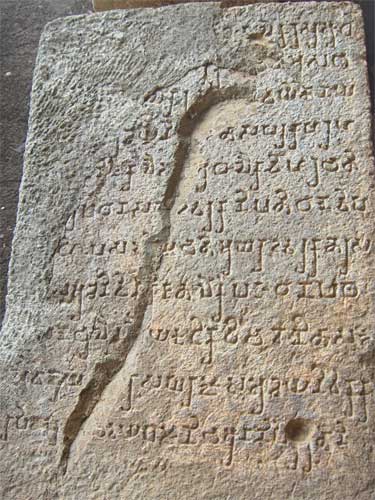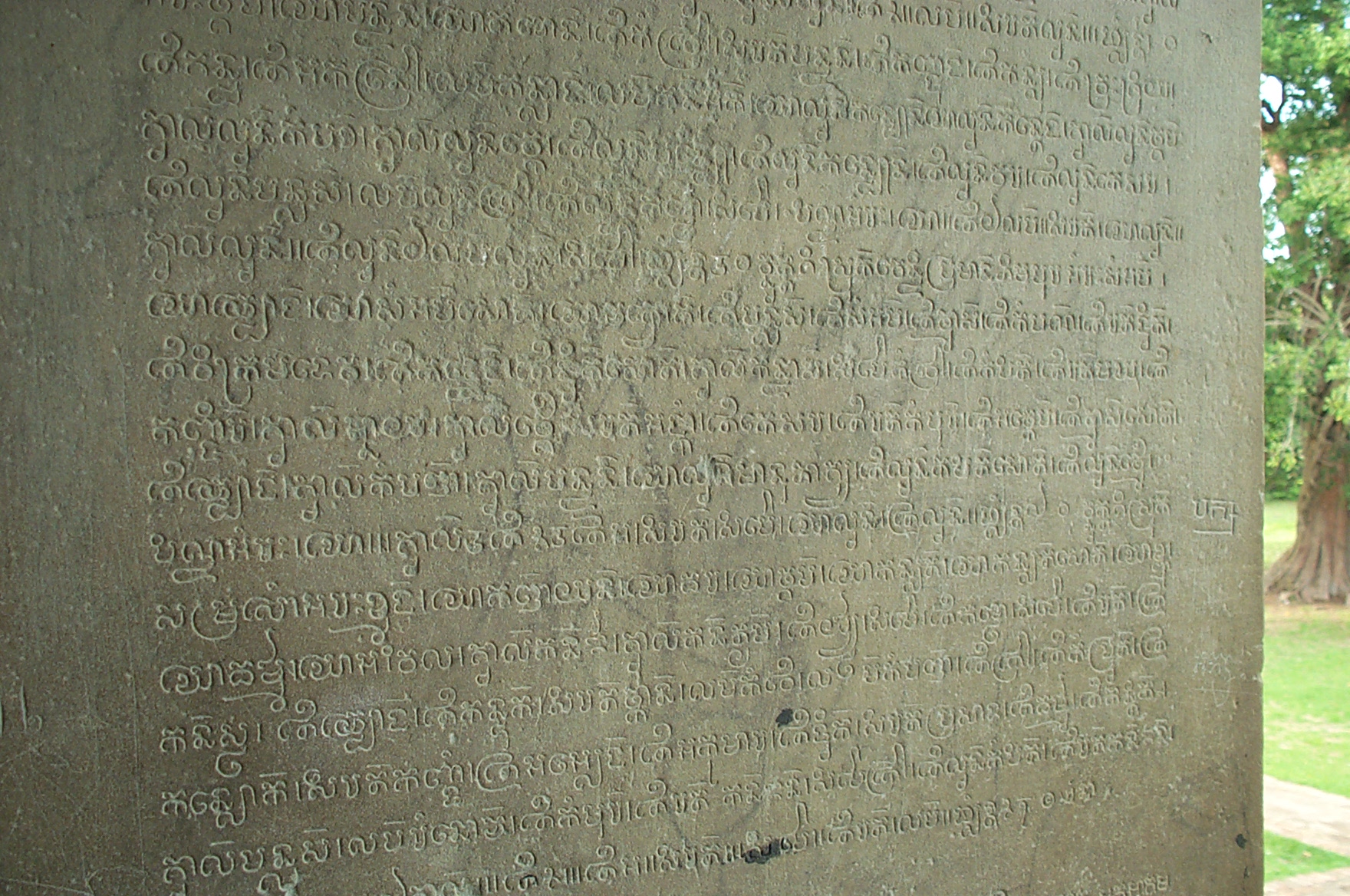|
Visarga
Visarga ( sa, विसर्गः, translit=visargaḥ) means "sending forth, discharge". In Sanskrit phonology ('' ''), ' (also called, equivalently, ' by earlier grammarians) is the name of a phone voiceless glottal fricative, , written as: Visarga is an allophone of and in pausa (at the end of an utterance). Since is a common inflectional suffix (of nominative singular, second person singular, etc.), visarga appears frequently in Sanskrit texts. In the traditional order of Sanskrit sounds, visarga and anusvāra appear between vowels and stop consonants. The precise pronunciation of visarga in Vedic texts may vary between Śākhās. Some pronounce a slight echo of the preceding vowel after the aspiration: will be pronounced , and will be pronounced . Visarga is not to be confused with colon. Types The visarga is commonly found in writing, resembling the punctuation mark of colon or as two tiny circles one above the other. This form is retained by most Indi ... [...More Info...] [...Related Items...] OR: [Wikipedia] [Google] [Baidu] |
Harvard-Kyoto
The Harvard-Kyoto Convention is a system for transliterating Sanskrit and other languages that use the Devanāgarī script into ASCII. It is predominantly used informally in e-mail, and for electronic texts. Harvard-Kyoto system Prior to the Unicode era, the following Harvard-Kyoto schemeAksharamukha transliteration tool Akshara Mukha is an Asian script (two way) converter. It converts between 20 different South Asian & East Asian scripts. It also supports 5 major Latin transliteration conventions such as IAST, ISO, Harvard Kyoto, ITRANS & Velthuis. You can access the project fro here While using the tool, 'source' can be set to for example: ITRANS or Harvard-Kyoto, and 'target' can be set to a particula ... [...More Info...] [...Related Items...] OR: [Wikipedia] [Google] [Baidu] |
Thai Alphabet
The Thai script ( th, อักษรไทย, ) is the abugida used to write Thai, Southern Thai and many other languages spoken in Thailand. The Thai alphabet itself (as used to write Thai) has 44 consonant symbols ( th, พยัญชนะ, ''phayanchana''), 16 vowel symbols ( th, สระ, ''sara'') that combine into at least 32 vowel forms and four tone diacritics ( th, วรรณยุกต์ or วรรณยุต, or ) to create characters mostly representing syllables. Although commonly referred to as the "Thai alphabet", the script is in fact not a true alphabet but an abugida, a writing system in which the full characters represent consonants with diacritical marks for vowels; the absence of a vowel diacritic gives an implied 'a' or 'o'. Consonants are written horizontally from left to right, and vowels following a consonant in speech are written above, below, to the left or to the right of it, or a combination of those. History The Thai alphabet is d ... [...More Info...] [...Related Items...] OR: [Wikipedia] [Google] [Baidu] |
Kannada Script
The Kannada script (IAST: ''Kannaḍa lipi''; obsolete: Kanarese or Canarese script in English) is an abugida of the Brahmic family, used to write Kannada, one of the Dravidian languages of South India especially in the state of Karnataka. Kannada script is also widely used for writing Sanskrit texts in Karnataka. Several minor languages, such as Tulu, Konkani, Kodava, Sanketi and Beary, also use alphabets based on the Kannada script. The Kannada and Telugu scripts share very high mutual intellegibility with each other, and are often considered to be regional variants of single script. Other scripts similar to Kannada script are Sinhala script (which included some elements from the Kadamba script), and Old Peguan script (used in Burma). The Kannada script ( ''akṣaramāle'' or ''varṇamāle'') is a phonemic abugida of forty-nine letters. The character set is almost identical to that of other Brahmic scripts. Consonantal letters imply an inherent vowel. Letters rep ... [...More Info...] [...Related Items...] OR: [Wikipedia] [Google] [Baidu] |
Kannada Alphabet
The Kannada script (IAST: ''Kannaḍa lipi''; obsolete: Kanarese or Canarese script in English) is an abugida of the Brahmic family, used to write Kannada, one of the Dravidian languages of South India especially in the state of Karnataka. Kannada script is also widely used for writing Sanskrit texts in Karnataka. Several minor languages, such as Tulu, Konkani, Kodava, Sanketi and Beary, also use alphabets based on the Kannada script. The Kannada and Telugu scripts share very high mutual intellegibility with each other, and are often considered to be regional variants of single script. Other scripts similar to Kannada script are Sinhala script (which included some elements from the Kadamba script), and Old Peguan script (used in Burma). The Kannada script ( ''akṣaramāle'' or ''varṇamāle'') is a phonemic abugida of forty-nine letters. The character set is almost identical to that of other Brahmic scripts. Consonantal letters imply an inherent vowel. Letter ... [...More Info...] [...Related Items...] OR: [Wikipedia] [Google] [Baidu] |
ISO 15919
ISO 15919 (Transliteration of Devanagari and related Indic scripts into Latin characters) is one of a List of ISO romanizations, series of international standards for romanization by the International Organization for Standardization. It was published in 2001 and uses diacritics to map the much larger set of consonants and vowels in Brahmic scripts, Brahmic and Nastaliq scripts to the Latin script. Overview Relation to other systems ISO 15919 is an international standard on the romanization of many Brahmic scripts, which was agreed upon in 2001 by a network of the national standards institutes of 157 countries. However, the Hunterian transliteration system is the "national system of romanization in India" and a United Nations expert group noted about ISO 15919 that "there is no evidence of the use of the system either in India or in international cartographic products." Another standard, United Nations romanization systems for geographical names, United Nations Romanizati ... [...More Info...] [...Related Items...] OR: [Wikipedia] [Google] [Baidu] |
Anusvara
Anusvara (Sanskrit: ') is a symbol used in many Indic scripts to mark a type of nasal sound, typically transliterated . Depending on its location in the word and the language for which it is used, its exact pronunciation can vary. In the context of ancient Sanskrit, ''anusvara'' is the name of the particular nasal sound itself, regardless of written representation. Sanskrit In Vedic Sanskrit, the anusvāra (lit. "after-sound" or "subordinate sound") was an allophonic (derived) nasal sound. The exact nature of the sound has been subject to debate. The material in the various ancient phonetic treatises points towards different phonetic interpretations, and these discrepancies have historically been attributed to either differences in the description of the same pronunciation or to dialectal or diachronic variation. In a 2013 reappraisal of the evidence, Cardona concludes that these reflect real dialectal differences. The environments in which the anusvara could arise, however, ... [...More Info...] [...Related Items...] OR: [Wikipedia] [Google] [Baidu] |
IAST
The International Alphabet of Sanskrit Transliteration (IAST) is a transliteration scheme that allows the lossless romanisation of Indic scripts as employed by Sanskrit and related Indic languages. It is based on a scheme that emerged during the nineteenth century from suggestions by Charles Trevelyan, William Jones, Monier Monier-Williams and other scholars, and formalised by the Transliteration Committee of the Geneva Oriental Congress, in September 1894. IAST makes it possible for the reader to read the Indic text unambiguously, exactly as if it were in the original Indic script. It is this faithfulness to the original scripts that accounts for its continuing popularity amongst scholars. Usage Scholars commonly use IAST in publications that cite textual material in Sanskrit, Pāḷi and other classical Indian languages. IAST is also used for major e-text repositories such as SARIT, Muktabodha, GRETIL, and sanskritdocuments.org. The IAST scheme represents more than ... [...More Info...] [...Related Items...] OR: [Wikipedia] [Google] [Baidu] |
Khmer Script
Khmer script ( km, អក្សរខ្មែរ, )Huffman, Franklin. 1970. ''Cambodian System of Writing and Beginning Reader''. Yale University Press. . is an abugida (alphasyllabary) script used to write the Khmer language, the official language of Cambodia. It is also used to write Pali in the Buddhist liturgy of Cambodia and Thailand. Khmer is written from left to right. Words within the same sentence or phrase are generally run together with no spaces between them. Consonant clusters within a word are "stacked", with the second (and occasionally third) consonant being written in reduced form under the main consonant. Originally there were 35 consonant characters, but modern Khmer uses only 33. Each character represents a consonant sound together with an inherent vowel, either ''â'' or ''ô''; in many cases, in the absence of another vowel mark, the inherent vowel is to be pronounced after the consonant. There are some independent vowel characters, but vowel sounds are ... [...More Info...] [...Related Items...] OR: [Wikipedia] [Google] [Baidu] |
Burmese Language
Burmese ( my, မြန်မာဘာသာ, MLCTS: ''mranmabhasa'', IPA: ) is a Sino-Tibetan language spoken in Myanmar (also known as Burma), where it is an official language, lingua franca, and the native language of the Burmans, the country's principal ethnic group. Burmese is also spoken by the indigenous tribes in Chittagong Hill Tracts ( Rangamati, Bandarban, Khagrachari, Cox's Bazar) in Bangladesh, Tripura state in Northeast India. Although the Constitution of Myanmar officially recognizes the English name of the language as the Myanmar language, most English speakers continue to refer to the language as ''Burmese'', after Burma, the country's once previous and currently co-official name. Burmese is the common lingua franca in Myanmar, as the most widely-spoken language in the country. In 2007, it was spoken as a first language by 33 million, primarily the Burman people and related ethnic groups, and as a second language by 10 million, particularly ethnic m ... [...More Info...] [...Related Items...] OR: [Wikipedia] [Google] [Baidu] |
Motoori Norinaga
was a Japanese scholar of ''Kokugaku'' active during the Edo period. He is conventionally ranked as one of the Four Great Men of Kokugaku (nativist) studies. Life Norinaga was born in what is now Matsusaka in Ise Province (now part of Mie Prefecture). His ancestors were vassals of the Kitabatake clan in Ise Province for many generations. However, in the early Edo period they abandoned their samurai status, changing their surname to Ozu, and relocated to Matsusaka, where they became cotton wholesalers. The family initially prospered and had a store in Edo as well. (The film director Yasujirō Ozu was a descendant of the same line). After his elder brother's death, Norinaga succeeded to the Ozu line. At one stage he was adopted out to a paper-making family but the bookish boy was not suited to business. It was at his mother's suggestion that, at the age of 22, Norinaga went to Kyoto to study medicine. In Kyoto, he also studied Chinese and Japanese philology under the neo-C ... [...More Info...] [...Related Items...] OR: [Wikipedia] [Google] [Baidu] |
Phonology
Phonology is the branch of linguistics that studies how languages or dialects systematically organize their sounds or, for sign languages, their constituent parts of signs. The term can also refer specifically to the sound or sign system of a particular language variety. At one time, the study of phonology related only to the study of the systems of phonemes in spoken languages, but may now relate to any linguistic analysis either: Sign languages have a phonological system equivalent to the system of sounds in spoken languages. The building blocks of signs are specifications for movement, location, and handshape. At first, a separate terminology was used for the study of sign phonology ('chereme' instead of 'phoneme', etc.), but the concepts are now considered to apply universally to all human languages. Terminology The word 'phonology' (as in ' phonology of English') can refer either to the field of study or to the phonological system of a given language. This is one ... [...More Info...] [...Related Items...] OR: [Wikipedia] [Google] [Baidu] |

.jpg)





